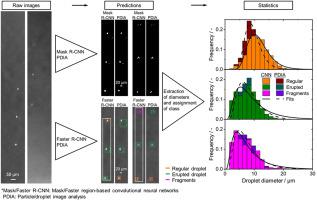Journal of Aerosol Science ( IF 4.5 ) Pub Date : 2023-12-10 , DOI: 10.1016/j.jaerosci.2023.106314 Niklas Jüngst , Veysel Ersoy , Gregory J. Smallwood , Sebastian A. Kaiser

|
Spray-flame synthesis (SFS) enables one-step production of functional metal-oxide nanoparticles from inexpensive precursors such as metal salts. Precursor-laden droplets show thermally-induced breakup, i.e., puffing and micro-explosion, considered a key step in SFS. In this work, shadowgraphy images of droplets are investigated with neural networks with the aim of extracting quantitative data on this breakup process. Faster and Mask region-based convolutional neural networks (R-CNNs) were applied to segment in-focus droplet shadowgraphs (Mask R–CNN) and to distinguish regular from disrupting droplets and detect sequences of consecutive droplet shadowgraphs (Faster R–CNN). The networks were trained with about 400 manually annotated images containing a total of about 1200 objects. Precision and recall of the trained networks reach 80% and 90%, respectively. The results from the two networks were combined and compared with those from conventional particle/droplet image analysis (PDIA). Mask R–CNN and PDIA identify similar droplets as being in-focus and segment similar regions of the droplets. Puffing or micro-explosion sometimes leave behind secondary droplets that are too small or defocused for reliable segmentation. Such shadowgraphs are classified erroneously by PDIA. In contrast to this, Faster R–CNN is more sensitive as it does not rely on the segmentation and thus classifies such low-contrast shadowgraphs correctly. Therefore, the CNNs find on average 30% higher droplet-disruption probabilities than PDIA.
中文翻译:

用于喷雾火焰合成中热致液滴破碎分类和分割的神经网络
喷雾火焰合成(SFS)可以利用金属盐等廉价前体一步生产功能性金属氧化物纳米颗粒。载有前体的液滴表现出热致破裂,即膨胀和微爆炸,这被认为是 SFS 的关键步骤。在这项工作中,通过神经网络研究了液滴的阴影图像,目的是提取有关该破碎过程的定量数据。Faster 和基于 Mask 区域的卷积神经网络 (R-CNN) 用于分割焦点内的液滴阴影图 (Mask R-CNN),区分规则液滴和破坏液滴并检测连续液滴阴影图的序列 (Faster R-CNN)。该网络接受了大约 400 张手动注释的图像的训练,其中总共包含大约 1200 个对象。训练后网络的准确率和召回率分别达到 80% 和 90%。将两个网络的结果组合起来,并与传统颗粒/液滴图像分析 (PDIA) 的结果进行比较。Mask R-CNN 和 PDIA 将相似的液滴识别为焦点一致,并分割液滴的相似区域。膨化或微爆炸有时会留下二次液滴,这些液滴太小或散焦,无法进行可靠的分割。PDIA 对此类阴影图进行了错误分类。与此相反,Faster R-CNN 更加敏感,因为它不依赖于分割,因此可以正确地对此类低对比度阴影图进行分类。因此,CNN 发现的液滴破坏概率比 PDIA 平均高 30%。



























 京公网安备 11010802027423号
京公网安备 11010802027423号